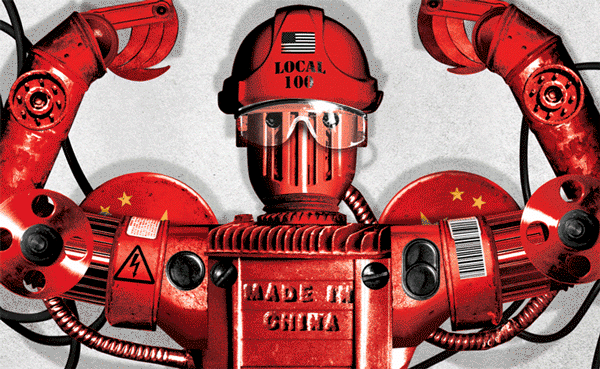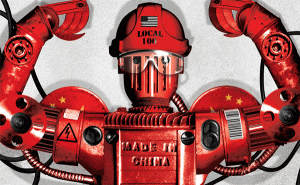NYT
Doug Chayka
Farhad Manjoo
Factories play a central role in President Trump’s parade of American horrors. In his telling, globalization has left our factories “shuttered,” “rusted-out” and “scattered like tombstones across the landscape of our nation.”
Here’s what you might call an alternative fact: American factories still make a lot of stuff. In 2016, the United States hit a manufacturing record, producing more goods than ever. But you don’t hear much gloating about this because manufacturers made all this stuff without a lot of people. Thanks to automation, we now make 85 percent more goods than we did in 1987, but with only two-thirds the number of workers.
This suggests that while Mr. Trump can browbeat manufacturers into staying in America, he can’t force them to hire many people. Instead, companies will most likely invest in lots and lots of robots.
And there’s another wrinkle to this story: The robots won’t be made in America. They might be made in China.
Industrial robots — which come in many shapes and perform a range of factory jobs, from huge, precisely controlled arms used to build cars to graceful machines that package delicate pastries — were invented in the United States. But in the last few years the Chinese government has spent billions to turn China into the world’s robotic wonderland.
In 2013, China became the world’s largest market for industrial robots, according to the International Federation of Robotics, an industry trade group. Now China is working on another big goal: to become the largest producer of robots used for factories, agriculture and a range of other applications.
Robotics industry experts said that goal could be a decade away, but they see few impediments to China’s eventual dominance.
“If you look at the comparisons in investment between China and the U.S., we’re going to lose,” said Henrik Christensen, director of the Contextual Robotics Institute at the University of California, San Diego. “The investments in China are billions and billions. I’m not seeing that investment in the U.S. And without that investment, we are going to lose. No doubt.”
There’s a way to address this problem, but it’s politically perilous: The United States should invest in robots. Mark Cuban, the internet and sports entrepreneur (and Trump nemesis), recently called on the president to offer $100 billion in funding for robotics. Frank Tobe, the publisher and editor of a trade magazine called The Robot Report, said government investment was imperative.
“We better do something, or we’re going to be behind the gun,” he said. “We should be in the robot business, not just users of foreign robots.”
If we don’t, robot scholars said the president’s plans for a resurgence in manufacturing could backfire. Today, we buy a lot of stuff made in China by Chinese people. Tomorrow, we’ll buy stuff made in America — by Chinese robots.
How China learned to love robots is instructive. For years, China’s chief selling point was cheap labor. But over the last couple of decades, its population has gotten older and richer, and its workers’ wages rose faster than the rate of economic growth. Chinese leaders worried that manufacturers would get priced out. In the same way that America lost manufacturing to China, Chinese manufacturers would lose work to India, Vietnam and other developing Asian economies.
So the Chinese did what the Chinese do: They centrally planned a revival. Over a succession of five-year economic plans, the government pushed a series of manufacturing reforms. One of its central ideas is automation. Local governments have offered billions in subsidies for companies to buy and manufacture robots. The government has been especially interested in building robots that can be installed in China’s car factories, which have been criticized for poor workmanship. Robots that build cars would not just save labor costs; the government also believes they would build better cars. In 2014, Xi Jinping, China’s president, called for a “robot revolution.”
Like other centrally planned initiatives, China’s robotics initiatives have not proceeded without trouble. There have been overinvestment and waste, and many Chinese robotics companies aren’t making very good robots.
“Many are low quality, and safety and design standards are really not good,” said Dieter Ernst, a senior fellow at the East-West Center, an organization that aims to improve Asian-American relations. “There are supposedly a bit more than 100 Chinese robot companies. I would say about 50 of these companies may survive.”
But the Chinese government and its companies are persistent. Mr. Ernst expects slow, steady gains in the Chinese robotics industry. And in five to 10 years, he predicts, China’s robot business will be producing industrial robots that are on par with those from Germany and Japan.
Pushing a robotics revival in the United States would be more difficult than in China, where there hasn’t been much outcry from workers over the government’s embrace of automation.
“There is not a public conversation in China about the pluses and minuses of automation,” said Scott Kennedy, a China scholar at the Center for Strategic and International Studies. “They don’t talk about the losers in society from globalization or potential automation.”
In the United States, on the other hand, losing is all we seem to talk about. Mr. Trump rose to power in part because he crystallized a feeling among voters that we have lost our edge to China. He promised to bring jobs back to America. In a hot-take political climate that can’t stomach nuance, an investment in robots would be seen as a betrayal of the manufacturing workers he promised to save.
But that would be a mistake. Mr. Christensen of the University of California, San Diego, pointed out that even the most automated of factories still employ people. To the extent that an investment in robotics might make it easier for companies to build their factories in the United States rather than in China, it might well create new jobs in the United States.
What’s more, America enjoys many advantages in robotics that China lacks. Some of the world’s leading roboticists work at American universities. The United States has a start-up culture that knows how to create big new companies. And America has a head start in the most advanced robotics technologies. For instance, American companies are the leading purveyors of surgical robots, and they are at the forefront of “collaborative robotics,” in which robots can work side by side with humans.
“All of this robotics technology was invented in the U.S., but we basically let other companies take it from us and make it cheaper, and now we’re buying it from them,” Mr. Christensen said. “In some sense, we’re not being very good at making sure we remain competitive in areas that we’re leading.”
And that’s how huge government funding can help, the robot experts said. As in China, an infusion from Mr. Trump could turn some of the most far-out ideas in robotics into a structural advantage for the American economy.
“What we can learn from the Chinese example is that the government plays a nurturing and fostering role for developing the robotics industry,” Mr. Ernst said. “We can do the same. We must do the same.”
Email: farhad.manjoo@nytimes.com; Twitter: @fmanjoo








